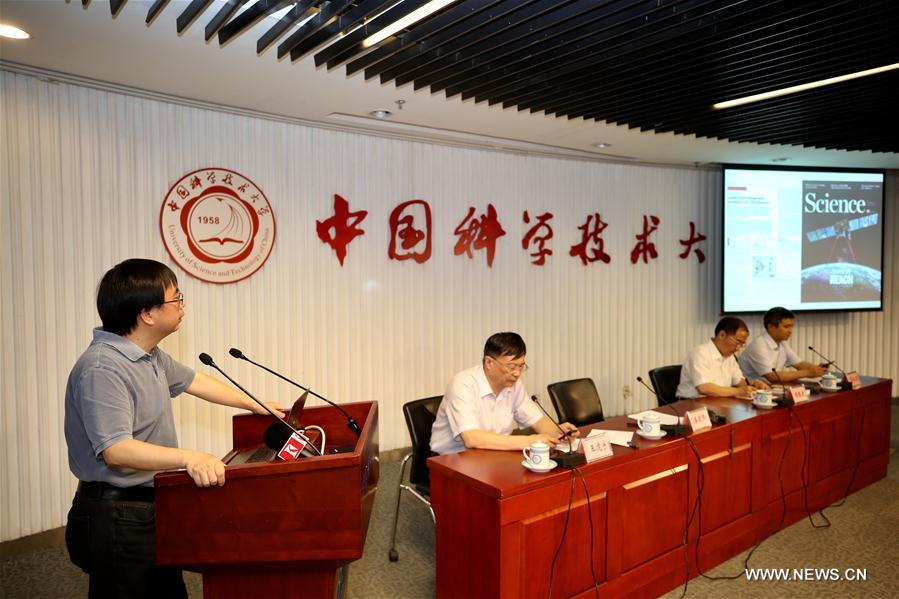China' s quantum satellite establishes photon entanglement over 1,200 km
Pan Jianwei, chief scientist for the quantum satellite project, speaks at a press conference at the University of Science and Technology of China, in Hefei, east China's Anhui Province, June 16, 2017. A team of Chinese scientists have realized the satellite-based distribution of entangled photon pairs over 1,200 kilometers. The photon pairs were demonstrated to be still entangled after travelling long distances. This satellite-based technology opens up bright prospects for both practical quantum communications and fundamental quantum optics experiments at distances previously inaccessible on the ground, said Pan Jianwei, an academician of the Chinese Academy of Sciences. (Xinhua/Jin Liwang)
HEFEI, June 16 (Xinhua) -- A team of Chinese scientists have realized the satellite-based distribution of entangled photon pairs over 1,200 kilometers. The photon pairs were demonstrated to be still entangled after travelling long distances.
This satellite-based technology opens up bright prospects for both practical quantum communications and fundamental quantum optics experiments at distances previously inaccessible on the ground, said Pan Jianwei, an academician of the Chinese Academy of Sciences.
The achievement was made based on the world' s first quantum satellite, Quantum Experiments at Space Scale (QUESS), also dubbed Micius, launched by China on August 16, 2016, and was published as a cover article in the latest issue of academic journal Science.
This experiment was made through two satellite-to-ground downlinks with a total length varying from 1,600 to 2,400 kilometers. The obtained link efficiency is many times higher than that of the direct bidirectional transmission of the two photons through telecommunication fibers, said Pan, who is also the lead scientist of QUESS.
Quantum entanglement is a phenomenon in quantum physics, which is so confounding that Albert Einstein described it as "spooky action at a distance" in 1948.
Scientists found that when two entangled particles are separated, one particle can somehow affect the action of the far-off twin instantly.
Scientists liken it to two pieces of paper that are distant from each other: if you write on one, the other immediately shows your writing.
The mystery of quantum entanglement has been puzzling scientists since it was detected.
Quantum physicists have a fundamental interest in distributing entangled particles over increasingly long distances and studying the behavior of entanglement under extreme conditions.
In theory, this bizarre connection can exist over any distance, but scientists want to see if there' s some physical limit. "If you want to explore new physics, you must push the limits," Pan said.
Previously, entanglement distribution had only been achieved at a distance up to 100 kilometers due to photon loss in optical fibers or terrestrial free space.
One way to improve the distribution lies in the protocol of quantum repeaters, whose practical usefulness, however, is hindered by the challenges of quantum storage and readout efficiency, Pan said.
Another approach is making use of satellite-based and space-based technologies, as a satellite can conveniently cover two distant locations on Earth. The main advantage of this approach is that most of the photons' transmission path is almost in a vacuum, with almost zero absorption and de-coherence, Pan said.
After feasibility studies, Chinese scientists developed and launched QUESS for the mission of entanglement distribution. Cooperating with QUESS are three ground stations: Delingha Observatory in Qinghai, Nanshan Observatory in Xinjiang and Gaomeigu Observatory in Yunan.
For instance, one photon of an entangled pair was beamed to Delingha and the other to Gaomeigu. The distance between the two ground stations is 1,203 kilometers. The distance between the orbiting satellite and the ground stations varies from 500 to 2,000 kilometers, said Pan.
Due to the fact that the entangled photons cannot be amplified as classical signals, new methods must be developed to reduce the link attenuation in the satellite-to-ground entanglement distribution. To optimize the link efficiency, Chinese scientists combined a narrow beam divergence with a high-bandwidth and a high-precision acquiring, pointing, and tracking (APT) technique.
An accurate transmission of photons between the "server" and the "receiver" is never easy, as the optic axis of the satellite must point precisely toward those of the telescopes in the ground stations, said Zhu Zhencai, QUESS chief designer.
What makes it much harder is that the satellite flying over the Earth at a speed of 8 kilometers per second can be continuously tracked by the ground station for just a few minutes.
"It is like tossing a coin from a plane at 100,000 meters above sea level exactly into the slot of a rotating piggy bank," said Wang Jianyu, QUESS project's chief commander.
The highly sensitive QUESS could make visible from the Earth a match being lit on the Moon, Wang added.
By developing an ultra-bright space-borne two-photon entanglement source and the high-precision APT technology, the team established entanglement between two single photons separated by 1,203 kilometers.
Compared with the previous methods of entanglement distribution by direct transmission of the same two-photon source -- using the best performance and most common commercial telecommunication fibers respectively -- the effective link efficiency of the satellite-based approach is 12 and 17 orders of magnitude higher, Pan said.
He said the distributed entangled photons are readily useful for entanglement-based quantum key distribution, which, so far, is the only way to establish secure keys between two distant locations on Earth without relying on trustful relay.
QUESS is also designed to establish "hack-proof" quantum communications by transmitting uncrackable keys from space to the ground, as well as test quantum teleportation with a ground station in Ali, Tibet.
Pan revealed they also want to see if it' s possible to distribute entanglement between the Earth and the Moon in future.

